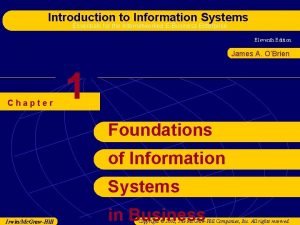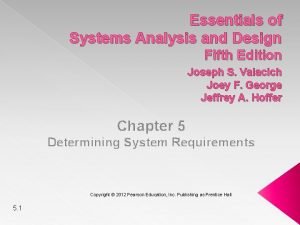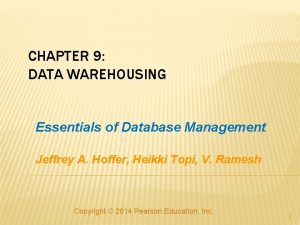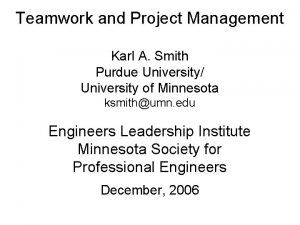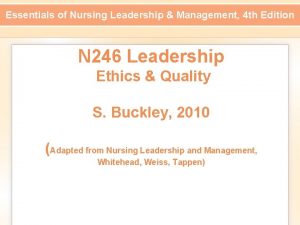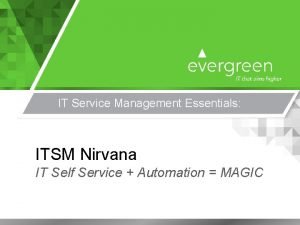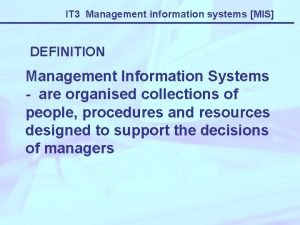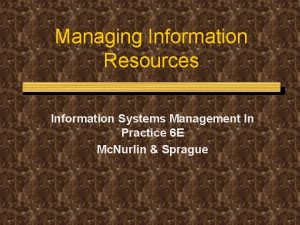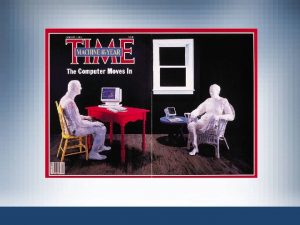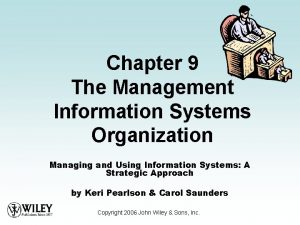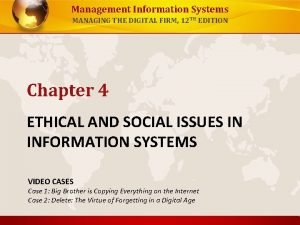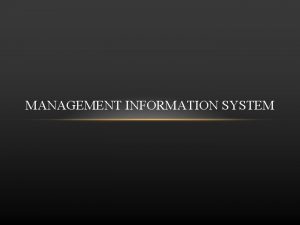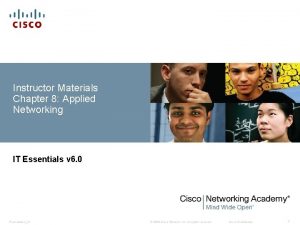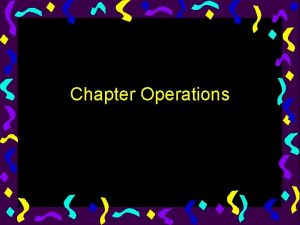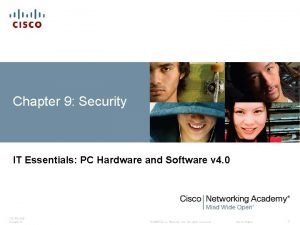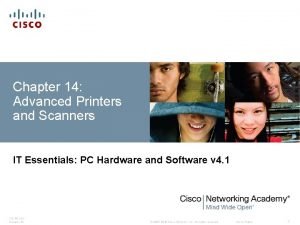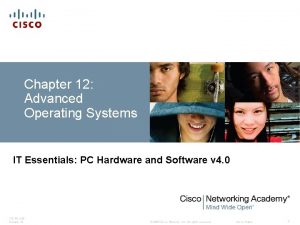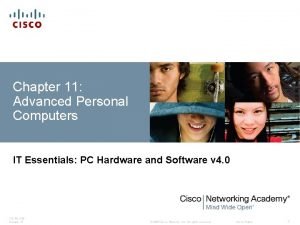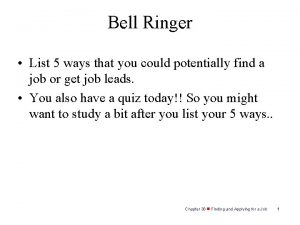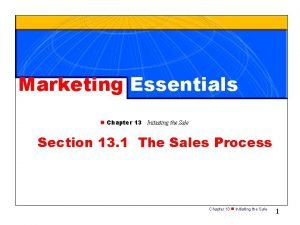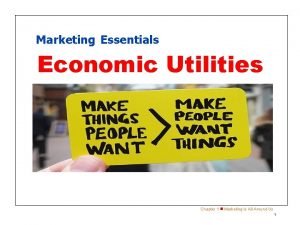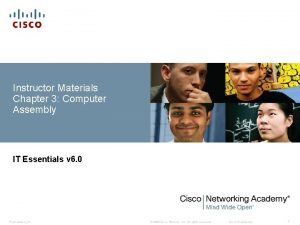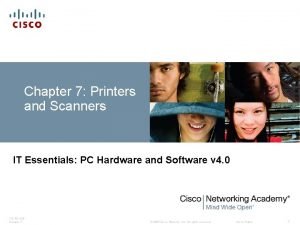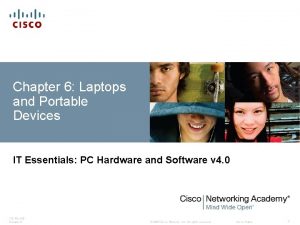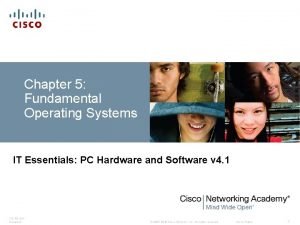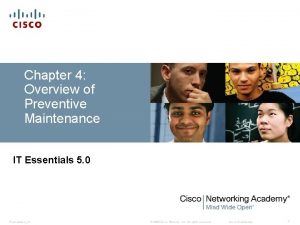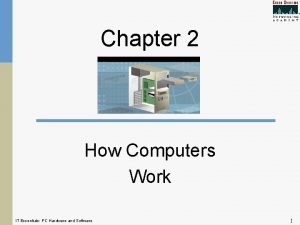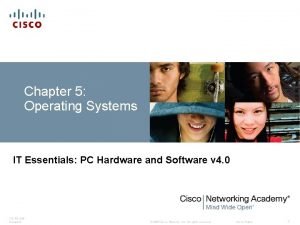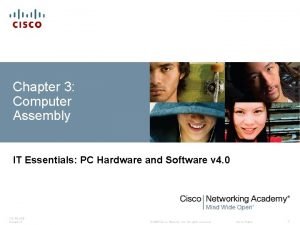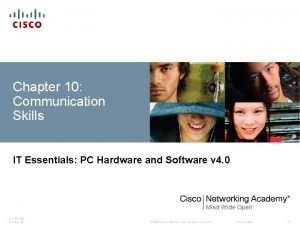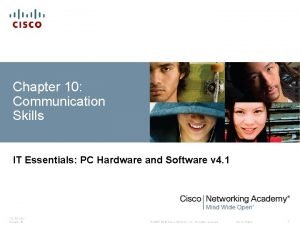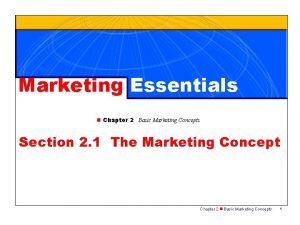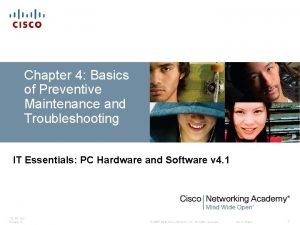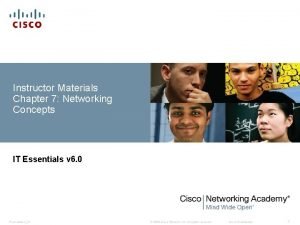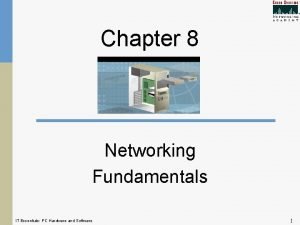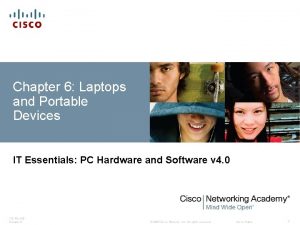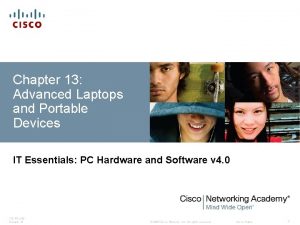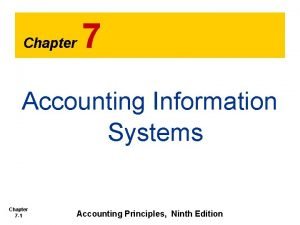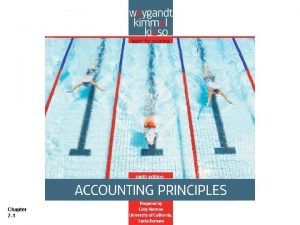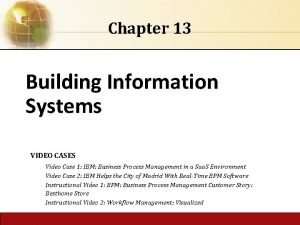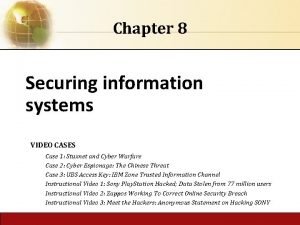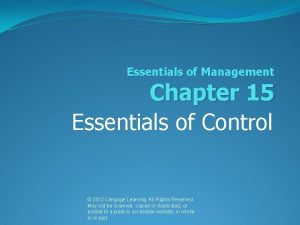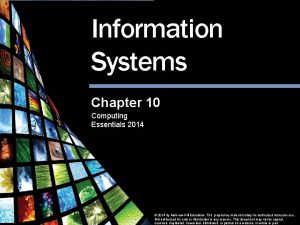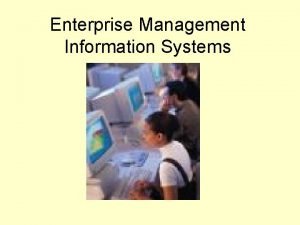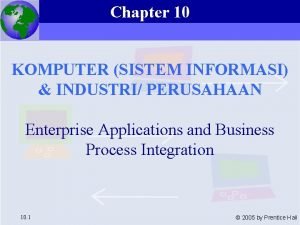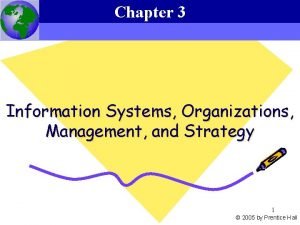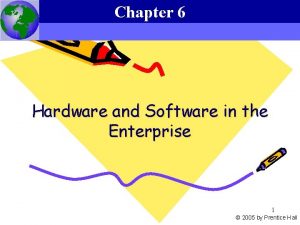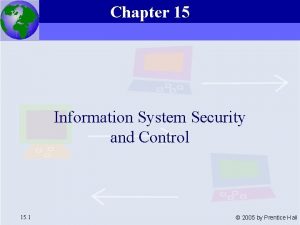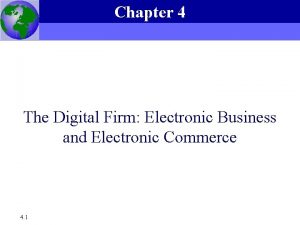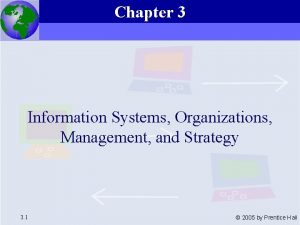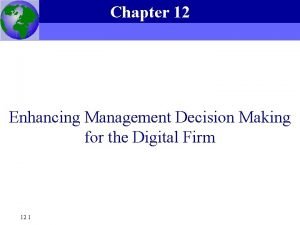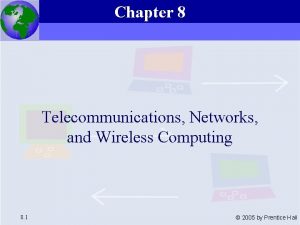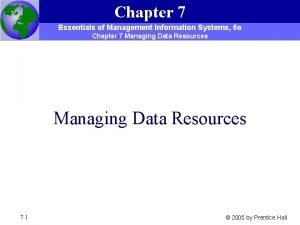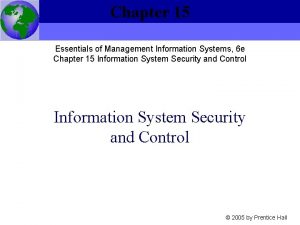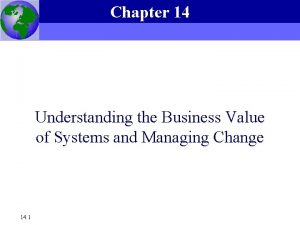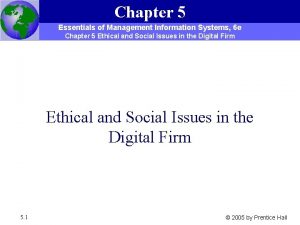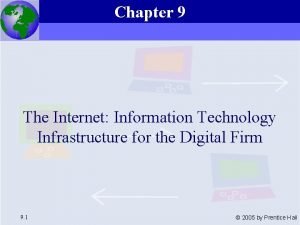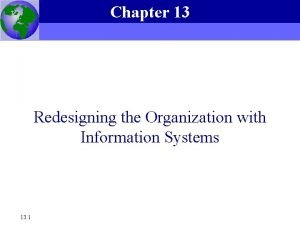Chapter 2 Essentials of Management Information Systems 6






























































- Slides: 62

Chapter 2 Essentials of Management Information Systems, 6 e Chapter 2 Information Systems in the Enterprise 1 © 2005 by Prentice Hall

Essentials of Management Information Systems, 6 e Chapter 2 Information Systems in the Enterprise Fast Fashion, Hot system 2 © 2005 by Prentice Hall

Essentials of Management Information Systems, 6 e Chapter 2 Information Systems in the Enterprise Major Types of Systems in Organizations Types of information systems Figure 2 -1 3 © 2005 by Prentice Hall

Essentials of Management Information Systems, 6 e Chapter 2 Information Systems in the Enterprise Major Types of Systems in Organizations Different Kinds of Systems Three Main Categories of Information Systems 1. Operational-level systems 2. Management-level systems 3. Strategic-level systems 4 © 2005 by Prentice Hall

Essentials of Management Information Systems, 6 e Chapter 2 Information Systems in the Enterprise Major Types of Systems in Organizations Four Major Types of Systems (P 42) 1. Transaction Processing Systems (TPS) 2. Management Information Systems (MIS) 3. Decision-Support Systems (DSS) 4. Executive-Support Systems (ESS) 5 © 2005 by Prentice Hall

Essentials of Management Information Systems, 6 e Chapter 2 Information Systems in the Enterprise Major Types of Systems in Organizations The four major types of information systems Figure 2 -2 6 © 2005 by Prentice Hall

Essentials of Management Information Systems, 6 e Chapter 2 Information Systems in the Enterprise Major Types of Systems in Organizations Four Major Types of Systems Transaction Processing Systems (TPS) • • • Basic business systems that serve the organization’s operational level Input: Transactions, events Processing: Sorting, listing, merging, updating Output: Detailed reports, lists, summaries Users: Operations personnel, supervisors 7 © 2005 by Prentice Hall

Essentials of Management Information Systems, 6 e Chapter 2 Information Systems in the Enterprise Major Types of Systems in Organizations A symbolic representation for a payroll TPS Figure 2 -3 8 © 2005 by Prentice Hall

Essentials of Management Information Systems, 6 e Chapter 2 Information Systems in the Enterprise Major Types of Systems in Organizations Typical applications of TPS Figure 2 -4 9 © 2005 by Prentice Hall

Essentials of Management Information Systems, 6 e Chapter 2 Information Systems in the Enterprise Major Types of Systems in Organizations Four Major Types of Systems Management Information Systems (MIS) • • • Serve management level; provide reports and access to company data Input: Summary transaction data, high-volume data, simple models Processing: Routine reports, simple models, lowlevel analysis Output: Summary and exception reports Users: Middle managers 10 © 2005 by Prentice Hall

Essentials of Management Information Systems, 6 e Chapter 2 Information Systems in the Enterprise Major Types of Systems in Organizations How management information systems obtain their data from the organization’s TPS Figure 2 -5 11 © 2005 by Prentice Hall

Essentials of Management Information Systems, 6 e Chapter 2 Information Systems in the Enterprise Major Types of Systems in Organizations A sample report that might be produced by the MIS in Figure 2 -5 12 © 2005 by Prentice Hall

Essentials of Management Information Systems, 6 e Chapter 2 Information Systems in the Enterprise Major Types of Systems in Organizations Four Major Types of Systems Decision-Support Systems (DSS) • • • Serve management level with data analysis for making decisions Input: Low-volume data or massive databases, analytic models, and data analysis tools Processing: Interactive, simulations, analysis Output: Special reports, decision analyses, responses to queries Users: Professionals, staff managers 13 © 2005 by Prentice Hall

Essentials of Management Information Systems, 6 e Chapter 2 Information Systems in the Enterprise Major Types of Systems in Organizations Voyage-estimating decision-support system(P 46) Figure 2 -7 14 © 2005 by Prentice Hall

Essentials of Management Information Systems, 6 e Chapter 2 Information Systems in the Enterprise • P 46 • Intrawest • DSS 15 © 2005 by Prentice Hall

Essentials of Management Information Systems, 6 e Chapter 2 Information Systems in the Enterprise Major Types of Systems in Organizations Four Major Types of Systems Executive Support Systems (ESS) • • • Provide communications and computing environment that serves the organization’s strategic level Input: External and internal aggregate data Processing: Graphics, simulations, interactive Output: Projections, responses to queries Users: Senior Managers 16 © 2005 by Prentice Hall

Essentials of Management Information Systems, 6 e Chapter 2 Information Systems in the Enterprise Major Types of Systems in Organizations Model of a typical executive support system Figure 2 -8 17 © 2005 by Prentice Hall

Essentials of Management Information Systems, 6 e Chapter 2 Information Systems in the Enterprise Major Types of Systems in Organizations Interrelationships among systems Figure 2 -9 18 © 2005 by Prentice Hall

Essentials of Management Information Systems, 6 e Chapter 2 Information Systems in the Enterprise Systems from a Functional Perspective Major Business Functions 1. 2. 3. 4. Sales and Marketing Systems Manufacturing and Production Systems Finance and Accounting Systems Human Resource Systems 19 © 2005 by Prentice Hall

Essentials of Management Information Systems, 6 e Chapter 2 Information Systems in the Enterprise Systems from a Functional Perspective Sales and Marketing Systems • • • Help identify customers Develop products and services Promote products and services Sell products and services Provide ongoing customer support 20 © 2005 by Prentice Hall

Essentials of Management Information Systems, 6 e Chapter 2 Information Systems in the Enterprise Systems from a Functional Perspective Table 2 -2: Examples of Sales and Marketing Information Systems System Description Organizational Level Order processing Enter, process, and track orders Operational Pricing analysis Determine prices Management for products and services Sales trend forecasting Prepare 5 -year sales forecasts Strategic 21 © 2005 by Prentice Hall

Essentials of Management Information Systems, 6 e Chapter 2 Information Systems in the Enterprise Systems from a Functional Perspective Manufacturing and Production Systems • • • Planning, development, production of products and services Planning, development, maintenance of production facilities Acquisition, storage, availability of materials Scheduling materials, facilities, labor Controlling the flow of production 22 © 2005 by Prentice Hall

Essentials of Management Information Systems, 6 e Chapter 2 Information Systems in the Enterprise Windows of organization (p 51) 23 © 2005 by Prentice Hall

Essentials of Management Information Systems, 6 e Chapter 2 Information Systems in the Enterprise Windows of organization (p 51) 24 © 2005 by Prentice Hall

Essentials of Management Information Systems, 6 e Chapter 2 Information Systems in the Enterprise Windows of organization (p 51) 25 © 2005 by Prentice Hall

Essentials of Management Information Systems, 6 e Chapter 2 Information Systems in the Enterprise Windows of organization (p 51) 26 © 2005 by Prentice Hall

Essentials of Management Information Systems, 6 e Chapter 2 Information Systems in the Enterprise Systems from a Functional Perspective Table 2 -3: Examples of Manufacturing and Production Information Systems System Description Organizational Level Machine control Control the actions of machines and equipment Operational Production planning Decide when and how many products should be produced Management Facilities location Decide where to locate new facilities Strategic 27 © 2005 by Prentice Hall

Essentials of Management Information Systems, 6 e Chapter 2 Information Systems in the Enterprise Systems from a Functional Perspective Overview of an inventory system Figure 2 -10 28 © 2005 by Prentice Hall

Essentials of Management Information Systems, 6 e Chapter 2 Information Systems in the Enterprise Systems from a Functional Perspective Finance and Accounting Systems • • • Manage firm’s financial assets: cash, stocks, bonds, etc. Manage capitalization of firm and finding new financial assets Maintain and manage financial records 29 © 2005 by Prentice Hall

Essentials of Management Information Systems, 6 e Chapter 2 Information Systems in the Enterprise Systems from a Functional Perspective Table 2 -4: Examples of Finance and Accounting Information Systems System Description Organizational Level Accounts receivable Track money owed the firm Operational Budgeting Prepare shortterm budgets Management Profit planning Plan long-term profits Strategic 30 © 2005 by Prentice Hall

Essentials of Management Information Systems, 6 e Chapter 2 Information Systems in the Enterprise Systems from a Functional Perspective Human Resources Systems • • Identify potential employees Maintain employee records Track employee skills, job performance, and training Support planning for employee compensation and career development 31 © 2005 by Prentice Hall

Essentials of Management Information Systems, 6 e Chapter 2 Information Systems in the Enterprise Systems from a Functional Perspective Table 2 -5: Examples of Human Resources Information Systems System Description Organizational Level Training and development Track employee training, skills, and performance Operational Compensation analysis Monitor wages, Management salaries, benefits Human resources planning Plan long-term Strategic labor force needs 32 © 2005 by Prentice Hall

Essentials of Management Information Systems, 6 e Chapter 2 Information Systems in the Enterprise Systems from a Functional Perspective An employee record-keeping system Figure 2 -11 33 © 2005 by Prentice Hall

Essentials of Management Information Systems, 6 e Chapter 2 Information Systems in the Enterprise Applications(p 54) Business Processes and Information Systems Business Processes • • • Manner in which work is organized, coordinated, and focused Concrete workflows of material, information, and knowledge Unique ways to coordinate work, information, and knowledge 34 © 2005 by Prentice Hall

Essentials of Management Information Systems, 6 e Chapter 2 Information Systems in the Enterprise Applications Business Processes and Information Systems Examples of Functional Business Processes • • Manufacturing and production: Assembling product, checking quality, producing bills of materials Sales and marketing: Identifying customers, creating customer awareness, selling 35 © 2005 by Prentice Hall

Essentials of Management Information Systems, 6 e Chapter 2 Information Systems in the Enterprise Applications Business Processes and Information Systems Examples of Functional Business Processes • • Finance and accounting: Paying creditors, creating financial statements, managing cash accounts Human Resources: Hiring employees, evaluating performance, enrolling employees in benefits plans 36 © 2005 by Prentice Hall

Essentials of Management Information Systems, 6 e Chapter 2 Information Systems in the Enterprise Applications Business Processes and Information Systems Cross-Functional Business Processes • Transcend boundary between sales, marketing, manufacturing, and research and development • Group employees from different functional specialties to a complete piece of work Example: Order Fulfillment Process 37 © 2005 by Prentice Hall

Essentials of Management Information Systems, 6 e Chapter 2 Information Systems in the Enterprise Applications The order fulfillment process Figure 2 -12 38 © 2005 by Prentice Hall

Essentials of Management Information Systems, 6 e Chapter 2 Information Systems in the Enterprise Applications Enterprise application architecture Figure 2 -13 39 © 2005 by Prentice Hall

Essentials of Management Information Systems, 6 e Chapter 2 Information Systems in the Enterprise Words from book • A organization typically has many different kinds of IS that support different functions, organizational levels, and business processes • Most of these systems were built around different functions, business units, and business processes that do not “talk” to each other and thus cannot automatically exchange information • This fragmentation of data in hundreds of separate systems could thus have a negative impact on organizational efficiency and business performance. 40 © 2005 by Prentice Hall

Essentials of Management Information Systems, 6 e Chapter 2 Information Systems in the Enterprise Applications Business Processes and Information Systems Enterprise Applications(P 57) • • Enterprise systems Supply chain management systems Customer relationship management systems Knowledge management systems 41 © 2005 by Prentice Hall

Essentials of Management Information Systems, 6 e Chapter 2 Information Systems in the Enterprise For instance at P 57 • Brussels ->order • factory in Hong Kong <-order and begins production. • The warehouse checks its progress online and schedules the shipment date and check its stock of parts and replenish whatever the factory has depleted. 42 © 2005 by Prentice Hall

Essentials of Management Information Systems, 6 e Chapter 2 Information Systems in the Enterprise For instance at P 57 • Customer track the progress of the order manufacturing process. • Updated sales and production data ->the accounting department. • The system transmits information for calculating the salesperson’s commission to the payroll department 43 © 2005 by Prentice Hall

Essentials of Management Information Systems, 6 e Chapter 2 Information Systems in the Enterprise For instance at P 57 • The system also automatically recalculates the company’s balance sheets, accounts receivable and payable ledgers, cost-center accounts, and available cash. • Headquarters in London can view up-to-the -minute data on sales, inventory, and production at every step of the process, as well as updated sales and production forecasts and calculations of product cost and availability. 44 © 2005 by Prentice Hall

Essentials of Management Information Systems, 6 e Chapter 2 Information Systems in the Enterprise Applications Traditional view of systems Figure 2 -14 45 © 2005 by Prentice Hall

Essentials of Management Information Systems, 6 e Chapter 2 Information Systems in the Enterprise Words from book(P 57) • In most organizations today, separate systems built over a long period of time support discrete business processes and discrete segments of the business value chain. • The organization’s systems rarely include vendors and customers. 46 © 2005 by Prentice Hall

Essentials of Management Information Systems, 6 e Chapter 2 Information Systems in the Enterprise Applications Enterprise Systems • • • Enterprise resource planning (ERP) Provides single information system for organization-wide coordination and integration of key business processes Models and automates many business processes Product: SAP by Germen User: China Power Grid, Taiyuan Steel 47 © 2005 by Prentice Hall

Essentials of Management Information Systems, 6 e Chapter 2 Information Systems in the Enterprise Applications Enterprise systems Figure 2 -15 48 © 2005 by Prentice Hall

Essentials of Management Information Systems, 6 e Chapter 2 Information Systems in the Enterprise Applications Supply Chain Management and Collaborative Commerce • Supply Chain Management Systems (SCM): Automate flow of information between firm and suppliers to optimize production and delivery • Supply Chain Management: Close linkage of activities involved in buying, making, moving a product • Supply Chain: Network of organizations and business processes for production and distribution of products 49 © 2005 by Prentice Hall

Essentials of Management Information Systems, 6 e Chapter 2 Information Systems in the Enterprise Applications A supply chain Figure 2 -16 50 © 2005 by Prentice Hall

Essentials of Management Information Systems, 6 e Chapter 2 Information Systems in the Enterprise Applications Information Systems Can Help Supply Chain Participants: • • Decide when and what to produce, store, and move Rapidly communicate orders Track status of orders Check and monitor inventory Reduce inventory, transportation, warehousing costs Track shipments Plan production based on actual customer demand Rapidly communicate changes in product design 51 © 2005 by Prentice Hall

Essentials of Management Information Systems, 6 e Chapter 2 Information Systems in the Enterprise Applications Supply Chain Management and Collaborative Commerce • Uses digital technologies to enable multiple organizations to collaboratively design, develop, build, move, and manage products • Increases efficiencies in reducing product design life cycles, minimizing excess inventory, forecasting demand, and keeping partners and customers informed 52 © 2005 by Prentice Hall

Essentials of Management Information Systems, 6 e Chapter 2 Information Systems in the Enterprise Applications Customer Relationship Management (CRM) • Manages ways used to deal with existing and potential customers • Both a business and technology discipline • Uses information systems to coordinate all customer interaction processes in sales, marketing, and service. 53 © 2005 by Prentice Hall

Essentials of Management Information Systems, 6 e Chapter 2 Information Systems in the Enterprise Applications Customer Relationship Management (CRM) Customer Relationship Management Systems • • Track all customer interactions Analyze data to optimize revenue, profitability, customer satisfaction, customer retention 54 © 2005 by Prentice Hall

Essentials of Management Information Systems, 6 e Chapter 2 Information Systems in the Enterprise Applications Customer Relationship Management (CRM) Figure 2 -17 55 © 2005 by Prentice Hall

Essentials of Management Information Systems, 6 e Chapter 2 Information Systems in the Enterprise 56 © 2005 by Prentice Hall

Essentials of Management Information Systems, 6 e Chapter 2 Information Systems in the Enterprise Applications Knowledge Management Systems in the Enterprise Knowledge Management Systems (KMS) • Collect relevant knowledge and experience in firm to support business processes and management decisions • Manage and distribute documents and other digital knowledge objects 57 © 2005 by Prentice Hall

Essentials of Management Information Systems, 6 e Chapter 2 Information Systems in the Enterprise Applications Knowledge Management Systems in the Enterprise • • Role of Knowledge Management Systems(P 61 -Table 2 -8) Acquire knowledge Store knowledge Distribute knowledge Apply knowledge 58 © 2005 by Prentice Hall

Essentials of Management Information Systems, 6 e Chapter 2 Information Systems in the Enterprise Chapter 2 Case Study HAWORTH OVERHAULS SUPPLY CHAIN MANAGEMENT 1. How did these supply chain management systems change the way Haworth worked? 2. What value do they provide? 59 © 2005 by Prentice Hall

Essentials of Management Information Systems, 6 e Chapter 2 Information Systems in the Enterprise Objectives 1. What are the major types of systems in a business? What role do they play? 2. How do information systems support the major business functions: sales and marketing, manufacturing and production, finance and accounting, and human resources? 60 © 2005 by Prentice Hall

Essentials of Management Information Systems, 6 e Chapter 2 Information Systems in the Enterprise Objectives 3. Why should managers pay attention to business processes? Why do firms need to integrate their business processes? 4. What are enterprise applications? What role do they play? What benefits do they provide? 5. What types of information systems are used by companies that operate internationally? 61 © 2005 by Prentice Hall

Essentials of Management Information Systems, 6 e Chapter 2 Information Systems in the Enterprise Management Challenges 1. Integration: Different systems serve variety of functions, connecting organizational levels difficult, costly 2. Enlarging scope of management thinking: Huge system investments, long development time must be guided by common objectives 62 © 2005 by Prentice Hall
 The time/space collaboration and social tool matrix
The time/space collaboration and social tool matrix Essentials of information systems
Essentials of information systems Functions of an information system
Functions of an information system Introduction of management information system
Introduction of management information system Essentials of systems analysis and design
Essentials of systems analysis and design Essentials of migration management
Essentials of migration management Essentials of database management
Essentials of database management One purdue success factors
One purdue success factors Essentials of migration management
Essentials of migration management Essentials of nursing leadership & management
Essentials of nursing leadership & management Essentials of migration management
Essentials of migration management Service management essentials
Service management essentials Mis systems examples
Mis systems examples Definition management information system
Definition management information system Information systems management in practice
Information systems management in practice Management information systems 16th edition
Management information systems 16th edition Specialized information systems
Specialized information systems Management information systems wiley
Management information systems wiley Management information systems effy oz
Management information systems effy oz Introduction to management information systems 5th edition
Introduction to management information systems 5th edition Management information systems managing the digital firm
Management information systems managing the digital firm Introduction of management information system
Introduction of management information system It essentials chapter 8
It essentials chapter 8 Ten essentials of a successful ffa chapter
Ten essentials of a successful ffa chapter It essentials chapter 9
It essentials chapter 9 It essential chapter 14
It essential chapter 14 It essentials chapter 12
It essentials chapter 12 It essential chapter 11
It essential chapter 11 Business essentials 12th edition chapter 1
Business essentials 12th edition chapter 1 Marketing essentials chapter 38
Marketing essentials chapter 38 Merchandise approach method
Merchandise approach method How is form utility not related to marketing
How is form utility not related to marketing It essential chapter 5
It essential chapter 5 It essentials chapter 3
It essentials chapter 3 It essentials chapter 11
It essentials chapter 11 Essentials of social media marketing chapter 9 quiz
Essentials of social media marketing chapter 9 quiz It essentials chapter 7
It essentials chapter 7 It essentials chapter 6
It essentials chapter 6 It essentials chapter 5
It essentials chapter 5 It essentials chapter 4
It essentials chapter 4 Chapter 4 kitchen essentials 1 answers
Chapter 4 kitchen essentials 1 answers It essentials chapter 2
It essentials chapter 2 It essential chapter 5
It essential chapter 5 Pata cable
Pata cable It essentials chapter 10
It essentials chapter 10 It essentials chapter 10
It essentials chapter 10 Meeting jesus in the sacraments chapter 1 crossword
Meeting jesus in the sacraments chapter 1 crossword Marketing essentials chapter 2
Marketing essentials chapter 2 Preventive maintenance and troubleshooting
Preventive maintenance and troubleshooting It essentials chapter 7
It essentials chapter 7 What are the ten essentials of a successful ffa chapter
What are the ten essentials of a successful ffa chapter What copper cored cable is surrounded by a heavy shielding
What copper cored cable is surrounded by a heavy shielding It essentials chapter 6
It essentials chapter 6 Chapter 5 kitchen essentials 2
Chapter 5 kitchen essentials 2 It essentials chapter 13
It essentials chapter 13 Chapter 8 securing information systems
Chapter 8 securing information systems Chapter 8 securing information systems
Chapter 8 securing information systems Chapter 7 accounting information systems
Chapter 7 accounting information systems Chapter 7 accounting information systems
Chapter 7 accounting information systems Chapter 13 building information systems
Chapter 13 building information systems Chapter 8 securing information systems
Chapter 8 securing information systems White-collar workers คือ
White-collar workers คือ Fundamentals of information system
Fundamentals of information system

